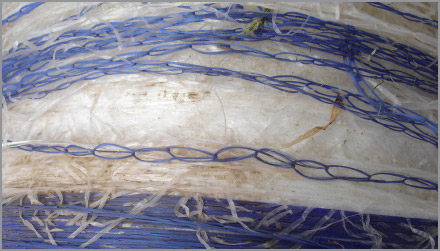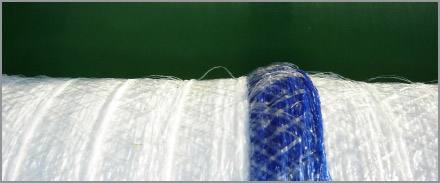 |
The single coloured thread will be different material and can be slightly thicker. This can make an uneven roll profile, with a ‘high point’, which causes problems in the baler where the roll is free turning in a box. The ‘high point’ of the net roll creates greater friction as the roll is turning, that will cause the net to break. |
 |
The different properties of the single coloured threads will cause differences in the net when being wound onto the roll. This can be an un-even roll edge profile, that can damage the edge of the net when the roll is turning in the baler. |
 |
It is possible that the different material of the coloured thread will not knit together correctly with the slit tapes of the rest of the net. This can create problems when feeding or cutting of the net. |
 |
The ‘normal’ slit film tapes of the net are completely uniform, with the same properties, as the tapes are all cut from the same ‘mother roll’ – unlike the single coloured thread which comes from a different source. |
 |
The coloured thread material can be of a different profile, making it less uniform in the net construction. |
What you want to believe …!
Netwrap has been with us for almost 25 years now. Many manufacturers have not developed their product, so it is very similar now to when first introduced in the mid 1980s. Initially, netwrap was all white, actually ‘natural’ in colour, with no colouring to the raw material at all.
Some manufacturers then introduced a single coloured thread on the sides of the netwrap, as a simple form of identification of their product; one manufacturer went so far as to register this single colour thread as a trademark. In any case, this single thread was nothing more than an identification mark.

Single coloured threads are no stronger than any other part of the netwrap and are only there for roll identification.
 |
In later years, the idea of a different coloured thread on either side was introduced, as a simple form of left/right identification, useful when loading the roll into the baler. |
 |
NOT STRONGER, just different |
| It is sometimes believed that the single coloured thread is a strengthening ‘rib’ on the net, made of stronger material. This is NOT TRUE.The strength of a net comes from the total of all of the threads across the width of the net and the edge thread does not have a greater strength than any of the other threads that make up the net. |
The normal way to make netwrap is for the material to all come from one ’mother roll’ of film, which is slit into tapes and knitted together in the loom. If a single coloured thread is added, this comes from another source and is introduced to the loom next to the film.
 |
 |
| The single coloured thread must be introduced into the net from a different source, most often from a single bobbin of material. | |
The coloured thread at the side of some makes of netwrap is often a slightly different material to the rest of the tapes. This means that when the net is being manufactured, the single coloured thread does not follow the same route through the production process as the remainder of the white tapes. This can have an effect on the quality of manufacturing, with the different material causing trouble from different tension of the thread compared with the others during the knitting process, which can then create un-even winding on the edges of the netwrap.
| As the single thread of different colour is of different specific material it will have different properties. This means that, when under load (tensioned during the wrapping operation in the baler) it is likely that the strength and elongation will vary considerably from the remaining film tapes from which the remainder of the net is made. This can result in a possible change in performance and weakening of the net where the single coloured thread is located. |  |
 Netwrap made with different striped netwrap pattern is not affected in this way.This two or sometimes three coloured ‘zebra’ patterned netwrap is made from individual coloured ‘mother’ rolls of film, of exactly the same material with all the same properties. The different films are then slit into narrow tapes, which are arranged into the striped pattern in the knitting loom. The entire net maintains its uniform, high strength across the full width as there is no introduction of different material to give the colour. Netwrap made with different striped netwrap pattern is not affected in this way.This two or sometimes three coloured ‘zebra’ patterned netwrap is made from individual coloured ‘mother’ rolls of film, of exactly the same material with all the same properties. The different films are then slit into narrow tapes, which are arranged into the striped pattern in the knitting loom. The entire net maintains its uniform, high strength across the full width as there is no introduction of different material to give the colour. |
PROBLEMS with single colour thread
The single coloured thread may have very different properties to the rest of the net, with a variance in material, thickness, elongation and strength. These differences can affect how the net reacts when under tension during roll winding, making the roll profile un-even.
 |
| The way the thread stretches when under tension in the baler might increase the risk of the net ‘necking-in’ and narrowing. |
 |
The different material and properties of the single coloured thread can affect the construction of the net, with the material not knitting into the rest of the net uniformly. This can cause problems in the baler when feeding and cutting. |
 |
The different material of the coloured thread can be thicker, creating an un-even profile on the roll. This can create problems in the baler, causing the net to break. |
 |
Often, when the net is cut at the end of the wrapping cycle in the baler, the single coloured thread will react differently to the rest of the net, creating the risk of the thread wrapping on feeding rollers. |





